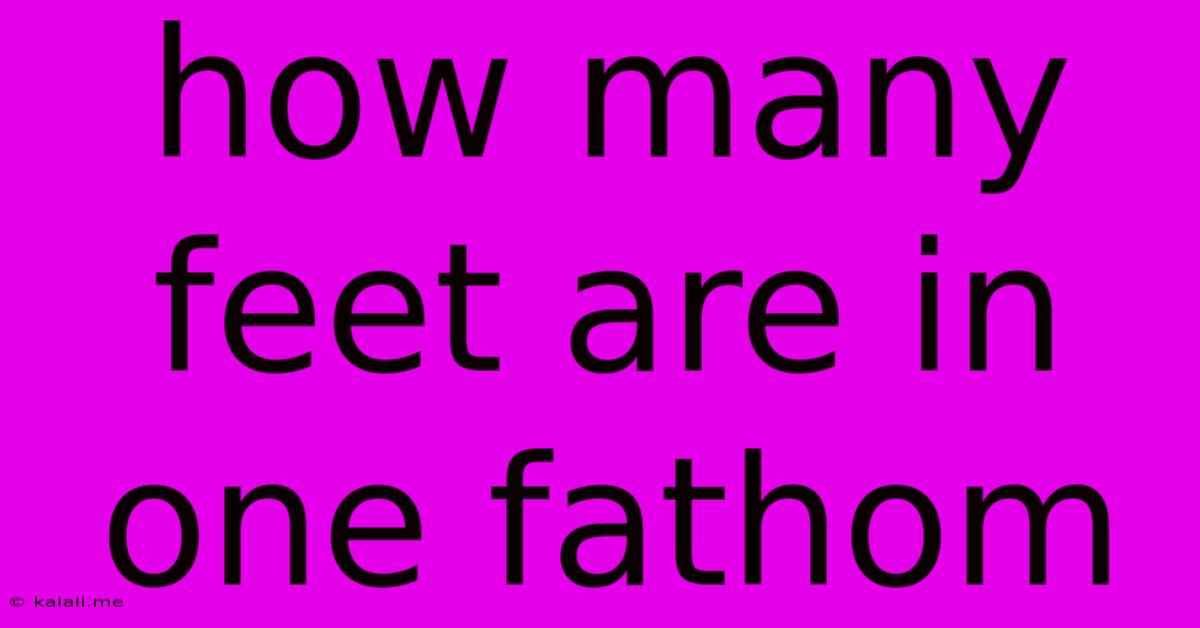How Many Feet Are In One Fathom
Kalali
Jun 13, 2025 · 3 min read

Table of Contents
How Many Feet Are in One Fathom? A Deep Dive into Nautical Measurements
Understanding nautical measurements can be tricky, especially for landlubbers! One unit that often causes confusion is the fathom. So, how many feet are in one fathom? The simple answer is six. But let's delve a little deeper into the history and practical applications of this ancient unit of measurement.
This article will explore the definition of a fathom, its historical context, its continued use today, and some related nautical measurements. We'll also address some common misconceptions surrounding fathoms.
The Definition of a Fathom
A fathom is a unit of length in the imperial and US customary systems equal to six feet (approximately 1.83 meters). Historically, it was defined as the distance between the outstretched hands of a tall man. This makes it a practical, readily available measurement tool for sailors in the past, allowing them to quickly measure water depth without the need for complex instruments.
Historical Context and Use
The fathom's origins trace back to ancient times, used by sailors to measure the depth of water using a sounding line – a rope with markers indicating fathoms. This was crucial for safe navigation, particularly in shallower waters or near coastlines. Its use wasn't limited to just depth; it also found applications in measuring the length of ship cables and other nautical equipment. The longevity of the fathom speaks to its practicality and usefulness within a maritime context.
Fathoms Today: Continued Relevance
While modern technology offers more precise and sophisticated methods for measuring water depth (like sonar), the fathom remains relevant in specific contexts. It's still commonly used in:
- Nautical charts: Many nautical charts still use fathoms to indicate water depth, particularly older charts. Understanding fathoms is thus essential for anyone interpreting these charts.
- Diving and underwater activities: Divers and other underwater professionals often encounter fathom measurements in their work, particularly when referencing depth limits or the location of underwater objects.
- Fishing: Fishermen sometimes use fathom measurements when discussing fishing depths or the length of fishing lines.
Fathoms vs. Other Nautical Measurements
It's important to differentiate fathoms from other related nautical units, such as:
- Cable: A cable length is typically 120 fathoms (720 feet).
- Nautical mile: While related to the fathom, a nautical mile is approximately 1,852 meters (6,076 feet).
Common Misconceptions about Fathoms
One common misconception is that a fathom is a variable measurement, depending on the person's arm span. While the historical definition is based on arm span, the standardized modern definition firmly establishes a fathom as exactly six feet. There's no longer any ambiguity about its length.
Conclusion: Understanding the Fathom's Significance
The fathom, although seemingly simple, represents a significant piece of maritime history and continues to hold practical relevance in several fields. Understanding this unit of measurement is crucial for anyone working in or studying nautical contexts, ensuring accurate interpretation of charts, effective communication within maritime professions, and a deeper understanding of our seafaring past. Remember: one fathom always equals six feet – a constant in the ever-changing world of the sea.
Latest Posts
Latest Posts
-
How Is Monopolistic Competition Similar To Perfect Competition
Jun 14, 2025
-
Correct The Following Sentences With Answers
Jun 14, 2025
-
Which Of The Following Is Not A Correctly Matched Pair
Jun 14, 2025
-
The Direction Of Natural Processes Is From States Of
Jun 14, 2025
-
What Is The Least Common Multiple Of 12 And 22
Jun 14, 2025
Related Post
Thank you for visiting our website which covers about How Many Feet Are In One Fathom . We hope the information provided has been useful to you. Feel free to contact us if you have any questions or need further assistance. See you next time and don't miss to bookmark.